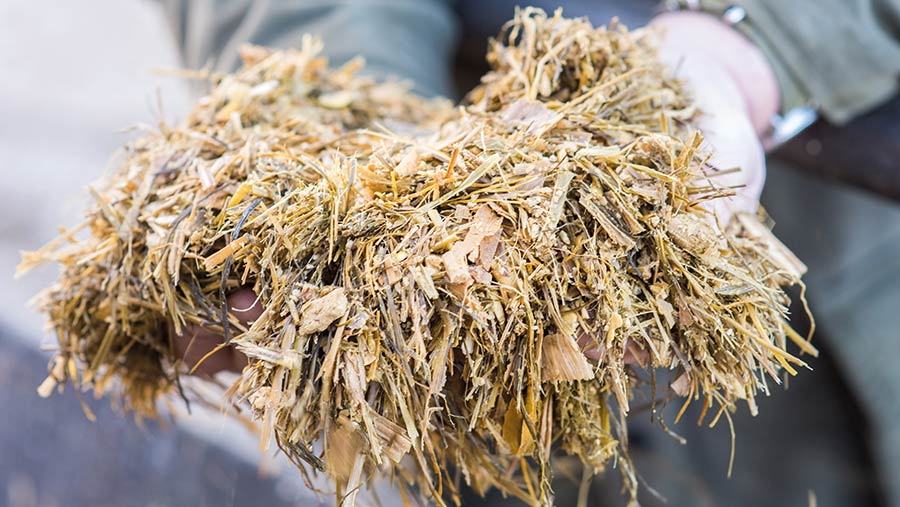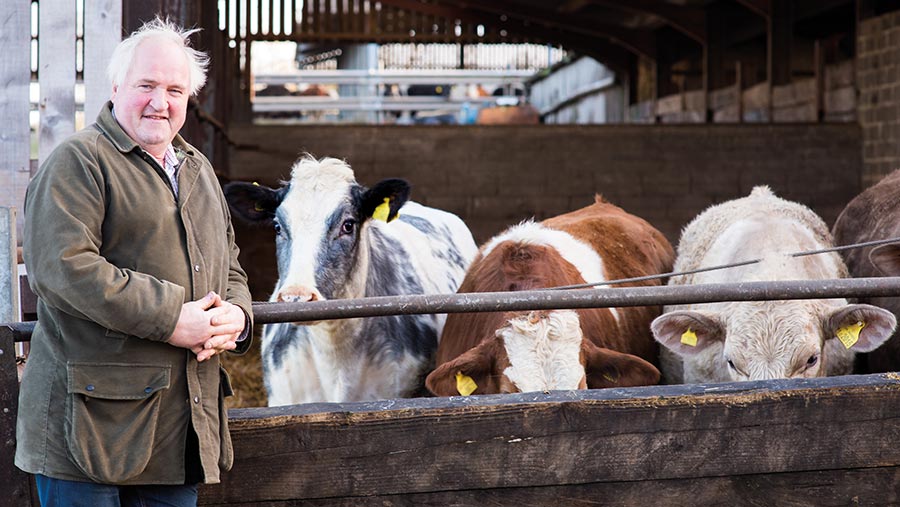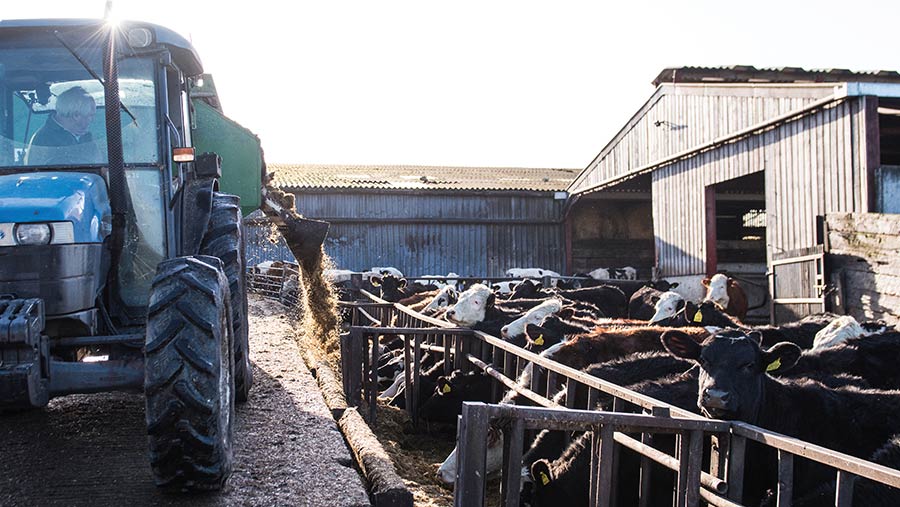How maize is helping beef producer hit target weights earlier
 © Katharine Davies
© Katharine Davies A focus on improving forage quality in beef rations has helped a Dorset farmer speed up throughput by up to six months.
Beef and arable farmer Stuart Casely is using maize to help produce high-quality forage for his cattle-rearing enterprise.
He farms with his wife, Tessa, at Gore Farm on the Trent Estate between Yeovil and Sherborne.
See also: How a farm’s switch to dairy-beef has upped output/ha by 75%
Throughput for the beef enterprise totals 250 cattle a year. Each week, Mr Casely sends five store cattle to Sedgemoor market and buys three- to four-month-old dairy cross beef calves to replace them.
Previously, he reared the cattle on grass silage, barley and minimal concentrates, but some cattle were struggling to reach target weight.
Having introduced maize silage in the ration, they are reaching 500kg up to six months earlier on less bought-in feed.
Farm facts: Gore Farm, Dorset
- 137ha (340-acre) tenant farm on Trent Estate, owned by educational charity Ernest Cook Trust
- 162ha (400 acres) grassland, including 24ha (60 acres) summer keep, with wheat grown as break crop between grass leys
- Additional 12ha (30 acres) used to grow two-year rotation of maize and wheat
- 250 cattle bought at three to four months and sold as stores at 500kg
- Higher Level Stewardship schemes for past 22 years
- On-farm educational centre for children and young people
Getting more from forage
Gore Farm has two types of grassland: long-term leys containing white clover, which are used for grazing youngstock after first-cut silage, and four-year leys without clover, used for cutting.
Wheat is grown as a one-year break between grass leys. The resulting straw and grain are used for the cattle, along with bought-in barley straw, and barley grain, which is milled on-farm.

Stuart Casely with his herd © Katharine Davies
Mr Casely’s independent nutritionist, Rob Mintern, suggested adding maize to the cattle rations as a source of starch.
Mr Casely had previous experience of growing maize when the farm ran a dairy herd and was happy to reintroduce it.
The aim is to get protein from grass and energy, and starch from maize, in a system that is flexible enough to cope with whichever calves he buys.
“For maize, my parameters are digestibility, yield, dry matter [DM], and the highest energy we can get – top-of-the-list stuff,” says Mr Mintern.
“But it’s also got to grow, so [I’m looking at] soil type, height of crop, and what else they are growing. There’s no point in going for really a high-yielding crop if they want [to grow] something else after it.
“I feed a lot of dairy farms and I bang on to all my clients about going for the best variety they can get. Pay attention to digestibility values [D-value] – if they are not over 70, you don’t want that near the cattle.”
For the past three years, Mr Casely has opted for the maize variety Dignity from Limagrain.
At 11.5MJ/kg metabolisable energy (ME), this season’s maize silage (see “Maize silage analysis for Gore Farm”) is “a bit lower than ideal”, says Mr Mintern.
He thinks this may be caused by last summer’s drought, as starch and DM are also on the high side.
However, there is no doubting the value of maize in the total mixed ration (TMR).
“It’s all about forage – that’s where we’re all heading, and maize plays a massive part in that,” he says. “If we can have 12ME grass and 12ME maize silage, I don’t need a lot else.”
Maize silage analysis for Gore Farm |
|
|
Dry matter (DM) % |
41.8 |
|
Digestibility value % |
73.2 |
|
Metabolisable energy MJ/kg |
11.5 |
|
Protein % |
8.2 |
|
Starch % |
36.9 |
|
Source: Duffields (South West), 1 March 2023. Maize variety: Dignity, from Limagrain |
|
See also: Nine new varieties added to forage maize Descriptive Lists
Tim Rutter, Mr Casely’s agronomist from Pearce Seeds, agrees the hot and dry conditions made for a very challenging season.
“The drought was pretty bad here – it was awful for grass growth and people were very glad they had maize,” he says.
“If you had a good seed-bed for maize, just enough moisture to get going, and then the heat and the sun kicked in, it grew so quickly and coped amazingly with the intense heat and dry.”
Preparing the ground
The maize is grown on 12ha (30 acres) of relatively free-draining, south- or west-facing limestone brash soils on level ground or gentle slopes three miles from the farm.
It is grown in a two-year rotation with wheat, with wheat stubbles and volunteers providing overwinter cover.
Six weeks before drilling maize, farmyard manure is spread at 62t/ha and ploughed into the wheat stubble.
The maize is sown with a starter fertiliser as soon as the soil temperature reaches 8C – typically on or around 5 May.
“We use a residual pre-emergence and an early post-emergence spray and have found that gives us best level of weed control,” says Mr Rutter.
“Weed control in maize is key – if maize has got early weed competition, it just will not do.”
Cattle rations
All cattle receive a TMR comprising grass and maize silage, wheat, home-milled barley, molasses, feed urea, soya and supplementary cake.
Four separate rations for the cattle are formulated according to age and budget.

© Katharine Davies
“We’re looking for faster growth rates with fewer inputs: get them in, grow them fast and out the door. We’ve gone from 24 months to 18 months at the same weight,” says Mr Mintern.
He puts this down to improving forage quality, which he says has been achieved in part by introducing maize into the rations.
All the cattle get some time out grazing, but generally are housed for their final 90-120 days.
“[We do this] so we can monitor and control their weight and condition more accurately and feed them to the same level of precision as a high-yielding dairy herd,” says Mr Casely.
The numbers
- 37 Average maize yield (t/ha) in 2022
- 42-52 Range of maize yield (t/ha) prior to 2022
- 6m Width of buffer strips around maize crops to protect hedges and watercourses
- 1.4kg/day Average daily liveweight gain of cattle at 16-20 months
Future plans
Further improvements to the beef system are under consideration ahead of the return of his son, Mark, to the farm.
One option could be to introduce a short-term break of Italian ryegrass into the maize-wheat rotation to provide an early first cut of silage. This would increase the amount of forage produced on that ground.
“It’s important to have as much really decent quality first cut as possible so that you’re getting value for money,” says Mr Mintern.
“Last year saw prices skyrocket, so farmers were paying £35/t in costs on first cut, while some third cuts were costing £70/t just in diesel, fertiliser and lack of yield.”
Another option is to grow more maize so it can be fed year-round – currently, there is a gap in the summer when grass-based rations with cereals are fed.
This could replace some of the wheat used as a break between grass leys. However, with a later harvest than wheat, it might prove harder to get a good entry for reseeding grass in early autumn.
